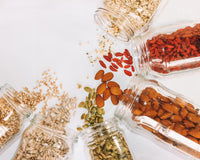What is Linseed and where does it come from?
Linseed is a small, reddish-brown or golden-yellow seed from the common flax plant, linum usitatissimum. This same plant has been used to grow the fibre from which linen has been made for thousands of years.
Linseed was first cultivated for food in the ancient civilization of Mesopotamia. Located in the Middle East over nine thousand years ago. However, there is evidence that suggests that it was woven into fabric as long as 30,000 years ago. It was important to successive empires, especially the Egyptians and Romans. The biggest producers of linseed today include Kazakhstan, Canada, Russia and China.
Linum usitatissimum, is an annual plant. Cultivated flax plants grow to have tall, slender stems. The leaves are green, with a slender lance-o-lated shape. Linum usitatissimum has flowers of a pure pale blue. The fruit growing on the plant is a round, dry capsule that contains several glossy brown seeds. It is shaped like an apple pip.

How did Linseed become popular?
Then
The use of Linseed first came into popularity for being cultivated extensively in ancient Egypt, where mummies were embalmed using linen. Egyptian temple walls had paintings of flowering flax. The earliest evidence of humans utilisation of wild flax was as a textile. It comes from the present-day Republic of Georgia, where knotted and dyed wild flax fibers were found in Dzudzuana Cave. These fibers date back to the Upper Paleolithic Era, 30,000 years ago! Humans first domesticated flax in the Fertile Crescent region (also known as Mesopotamia). Flax was popular among Egyptian priests, who only wore linen as the flax plant was considered a symbol of purity.
Now
Over the years Flax naturally adapted to the new environments through the passage of time. This is due to a specific set of genes that enable the Flax plant to change its make up according to researchers in the School of Life Sciences at the University of Warwick. Flash forward to today Flax still maintains long-lasting popularity and superfood status due to its rich fibre and fatty acid profile. Along with especially powerful antioxidant compounds known as lignans, Linseed offers a slew of advantages. Such as aiding to reduce heart disease and stroke. Linseed is rich in Omega-3s known to be beneficial for proper brain function. The combined effect of Linseeds' three major health properties can lower cholesterol, aid with digestive health, and so much more!
What is Linseed used for?
The benefits of linseed were reaped even in ancient times. Linseed was employed as one of the original medicines. Used by Hippocrates (a Greek physician) as a relief to intestinal abdominal pains. Look at that! Linseed has been taking care of our digestive woes since 400 BC. Linseeds’ main benefit (aside from its impressive fibre content) is that it is loaded with nutrients. One tablespoon of Linseeds provides a fair amount of protein and omega-3 fatty acids, in addition to being a very rich source of vitamins and minerals.
Linseeds are popularly used in baking as a binding agent. An attractive vegan approved alternative to egg known as ‘flax egg’. Flax also works nicely when added into cakes, muffins and biscuits. The seeds can be added into water as part of daily hydration. Mixing them into your favourite yoghurt or porridge or blitzing them in smoothies to thicken up the consistency. Linseeds can even be incorporated into meat and veggie patties alike! There are also other linseed derivatives such as ground linseed and linseed oil. Which may easily be drizzled over salads or sprinkled over different kinds of porridge.
Where to Buy?
The most recommended places are likely your local wholefood provider or grocer. As Linseeds have recently become incredibly popular, boasting a superfood profile they may also be available at your local shop or supermarket chain. Though this may not be guaranteed… lucky for you we’ve got your back. Wholefood Earth offers a variety of different Linseed products.






